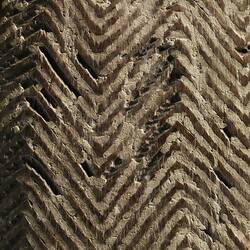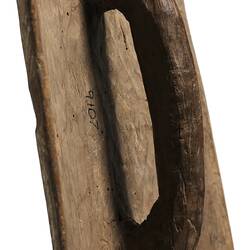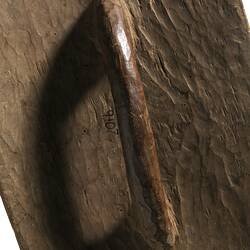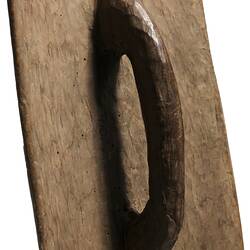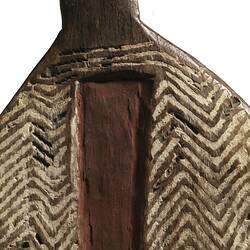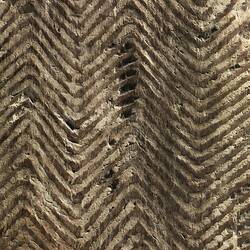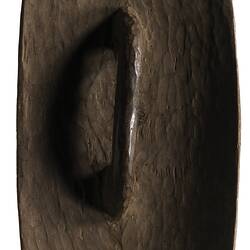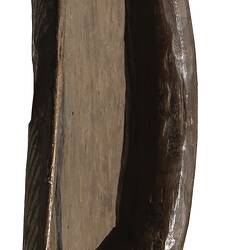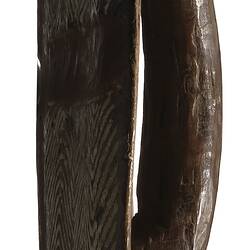Summary
Broad yangku (shields) were used in group fights to deflect spears; they are wider and lighter than the parrying yangku used in one-on-one combat. The whole structure of this yangku, including the handle, has been cut from a single piece of solid timber. Stone tools were used to remove the bark and outer wood from the eucalyptus tree and to shape the yangku. Some men sharpened a piece of kangaroo leg bone to use as a chisel for cutting out the handle of these wooden yangku.
The ornamentation has been created by the skilful use of a tool formed by one side of a possum's under jaw and tooth, fixed to a wooden handle to create an engraver. The craftsman would use the engraver to make deep gouges in straight, wavy or zigzag lines, depending on the design being created.
The tool is also used as a scoop, to remove small pieces of wood as he engraves. This method allowed the craftsman to make intricate and elaborate designs with a neat finish. This yangku has been coated in red ochre, and the incisions filled with white pipeclay to create the complex and beautiful incised designs.
Physical Description
Thin carved wooden spear shield that is paddle-shaped with rectangular extensions at top and bottom. It is shallowly convex and the underside has been hollowed away to leave a handle in the centre. The underside and extensions are undecorated but the main face has a vertical and a horizontal stripe painted red brown dividing the face into quarters. The quarters have chevron patterns of parallel incised lines filled with white clay.
Significance
The shield was made by a Barkindji man sometime around 1890. The Barkindji people are the recognised traditional owners of the area comprising the lower Darling River which they call the Barka, Barkindji literally meaning "people of the Barka". The homelands of the Barkindji extend from what is now Wentworth in the Riverina, northward through the Murray Darling Depression and into the Darling Riverine Plains beyond Wilcannia.
Barkindji cultural ambassador and respected artist Uncle Badger Bates continues to use and pass on techniques and art styles taught to him by his elders which have survived for hundreds of generations. Uncle Badger holds and shares a wealth of knowledge on the subject of identity, culture and stories of the land represented in specific Barkindji designs. Upon seeing the designs of his Barkindji Ancestors both at Mutawintji National Park (in paintings and rock engravings) and also at the Australian Museum in Sydney, Uncle Badger recalls;
'I just felt proud in my mind [that] I knew it through what Granny taught me'.
Reference Bates, B. https://www.mca.com.au/media/uploads/files/ITB_Education_Kit_v3.pdf
More Information
-
Object/Medium
Shield
-
Maker
-
Locality
-
Date Produced
-
Object Measurements
950 mm (Length), 240 mm (Width), 70 mm (Height)
-
Classification
-
Date Made
-
Maker
-
Clan/Language Group
-
Place Made
-
Indigenous Region
-
Keywords
-
Collection Names
-
Type of item
-
Discipline
-
Category
-
Collecting Areas


